Cappadocia: Visiting the Goreme Open Air Museum
20 July, 2008, 05:47 am in "Turkey"
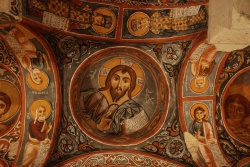 Hoping to beat the tour groups, we hurriedly left the hotel around 8:30. It was already warm as we walked the 1 km to get to the Open Air Museum. We were, unfortunately, passed by a couple tour buses. We made our way up the hill, avoiding an arrowed sign "To Goreme Open Air Museum" which directed unwary readers on a detour through a row of shops, restaurants, souvenir stands, and a camel contentedly munching on a pile of hay.
Hoping to beat the tour groups, we hurriedly left the hotel around 8:30. It was already warm as we walked the 1 km to get to the Open Air Museum. We were, unfortunately, passed by a couple tour buses. We made our way up the hill, avoiding an arrowed sign "To Goreme Open Air Museum" which directed unwary readers on a detour through a row of shops, restaurants, souvenir stands, and a camel contentedly munching on a pile of hay.Once in the museum area, we skipped the first church because it was full of a tour group. The museum was a series of wide based white cone-shaped rock towers. Carved holes led inside. Some had simple painted decorations marking doors and windows. We followed the cobblestone path to another rock tower. A narrow tunnel led through the rock to another tiny church: also full of a tour group. Speeding on, we managed to get ahead of the tour groups and get inside some of the rock churches. The dark interiors had barrel vaults and rough domes carved into the rock. Some had the remains of frescoes that looked simple but well done. Other parts of the walls were decorated with simple red lines and ornaments that looked, in contrast to the other frescoes, child-like.
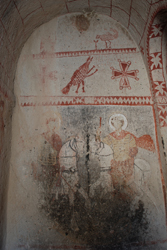
One room had a long table and benches carved into the stone.
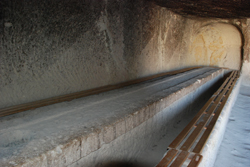
Some of the interiors had carved columns and alcoves.
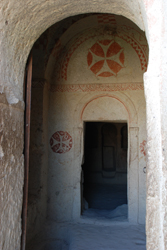
We looked at a couple other churches with highly damaged fresco remains. Then we approached the "Dark Church"--named so because it was lit by just one tiny window. We had to pay extra but it was worth it. This church was covered with well preserved frescoes in Byzantine style. Christ Pantocrator looked down from the domes. The walls were filled with pictures from Jesus' life.
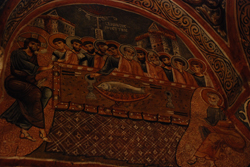
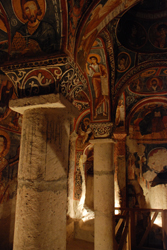
At one point the walls had been entirely covered with pictures. Strangely out of place were the black and white columns decorated with wavy lines that looked straight out of 70s psychadelia.
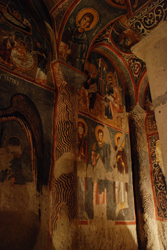
We spent a long time in the church expecting to be forced out at any minute by a tour group. But, none came. There had only been 2 people there when we walked in and only 3 more walked in and out while we were there. We enjoyed leisurely looking at the paintings and relaxing in the cool darkness. Outside we could hear the loud voices of groups going by but none came in. It turned out that the tour groups tend to skip the finest church in the complex.
Outside, we managed to visit the churches we had skipped due to crowds. They didn't seem too amazing after the "Dark Church" though. Since we had been moving around so slowly, the tour groups eventually disappeared, leaving the museum quiet and empty.
We made a final stop at the Tocali Church which also had fine walls of frescoes. This church was bigger and had a crypt underneath.
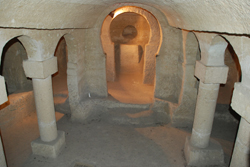
In the church, I realized why churches were decorated with both finely painted frescoes and rough line patterns. In Tocali, it was evident that originally, the church had been decorated with pigment lines and patterns. Eventually, this was covered with plaster and the more sophisticated frescoes were painted. There seemed to be 2 types of the sophisticated frescoes in the church as well-- one which included simpler images with broader strokes, while the other looked closer to the Byzantine mosaics with more delicate subtleties in fabric and features.
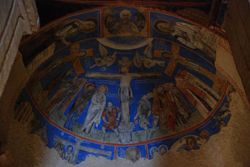
Back into the sun, we walked to "Love Valley" (Zemi Valley), named for the presence of rather narrow vertical fairy chimneys that looked more like a part of masculine anatomy than anything a fairy would light a fire underneath. We walked between the rocks, then up a hill/rock ridge, that separated the valley from Goreme.
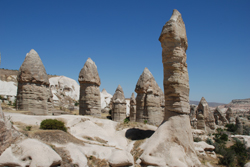
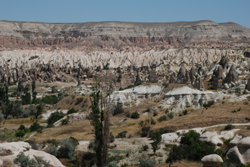
We ended up spending a lot of time our last day, hanging out at the motel. R played backgammon with some of the guys there and chatted. They were kind enough to let us even though we had technically checked out in the morning. Rowshan also made friends with one of the neighborhood kids who eagerly showed him his bicycle.
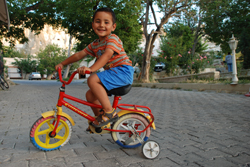
Comments
- Comments
Powered by My Blog 1.69. Copyright 2003-2006 FuzzyMonkey.net.
Created by the scripting wizards at FuzzyMonkey.net..
(Code modified by Rowshan Dowlatabadi)
Created by the scripting wizards at FuzzyMonkey.net..
(Code modified by Rowshan Dowlatabadi)

